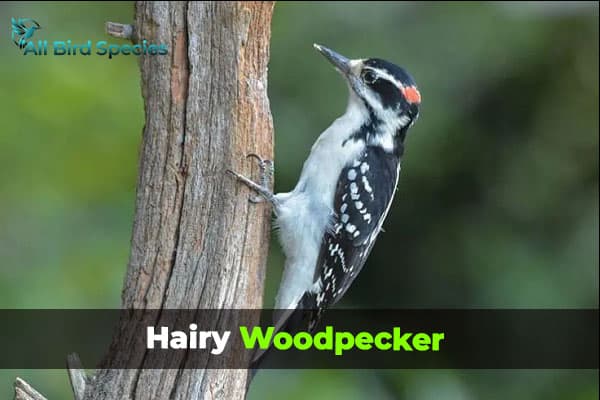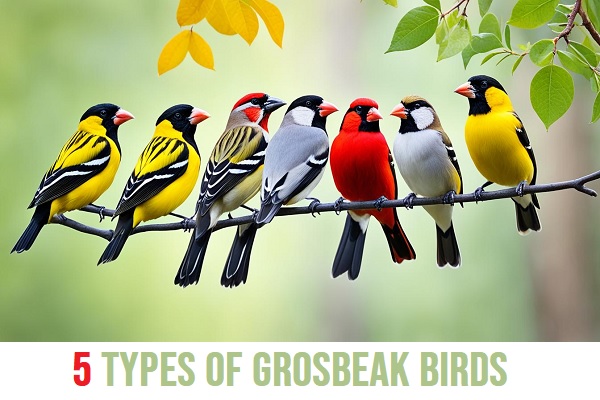7 Types of Woodpeckers In Tennessee (With Pictures)
Tennessee’s diverse landscapes are a haven for over 430 bird species, including the intriguing Woodpeckers in Tennessee. Nestled between the Great Smoky Mountains and the Mississippi River, this state’s rich habitats range from mountainous east to river-bordered west. Woodpeckers here thrive, using their zygodactyl toes and sharp beaks to forage in trees and craft cavity nests. Also, There are unique adaptations, like nostril-covering hairs and sturdy tails, that showcase nature’s ingenuity in these vibrant ecosystems.
Here we’ll learn about 7 different types of woodpeckers in Tennessee
1. Pileated Woodpecker
- Scientific name – Dryocopus pileatus
- Lifespan – 12 years (maximum recorded)
- Size – (40 to 49 cm)
- Weight – (250 to 350 g)
- Wingspan – (66 to 75 cm)
- Status – Least concern
The Pileated Woodpecker is a big bird with a black body, a red crest on its head, and a white-striped face and neck. You can tell a male from a female because the male has a red stripe on his cheek, while the female’s is black. Also, the top of the male’s head looks red, but the female’s is black. They make a high-pitched noise.

These woodpeckers make their homes by digging holes in dead trees. They don’t put anything soft inside, just some wood chips at the bottom. They don’t use the same hole every year. The mom lays three to five eggs, and they take about two to three weeks to hatch. Then, about a month later, the babies leave the nest.
Pileated Woodpeckers mostly eat carpenter ants, but they also like fruit, nuts, and other bugs sometimes. There are lots of them around, about 2.6 million, and their numbers are growing.
But their homes are in danger because people often get rid of dead trees, thinking they look bad.
2. Hairy Woodpecker
- Scientific name – Dryobates villosus
- Lifespan – 15 years (maximum recorded)
- Size – 7.1 to 10.2 in
- Weight – 1.4 to 3.4 oz
- Wingspan – 13 to 16.1 in
- Status – Least concern
The Hairy Woodpecker is a medium-sized bird with black feathers on its back and white feathers underneath. It has white spots on its wings and a striped head that’s black and white. The male has a red spot on the back of its neck, but the female’s is black. Its tail feathers are black, which helps tell it apart from another kind of woodpecker called the Downy Woodpecker. When it makes noise, it sounds like a sharp “peek.”

These woodpeckers make their homes by carving holes on the underside of tree stumps or in weak parts of trees. Inside the hole, there are no soft materials, just some wood chips at the bottom. They make a new home every year. The mom usually lays three to six eggs at once, and they take about 11 to 12 days to hatch. After they hatch, it takes about 28 to 30 days before the babies are ready to fly.
Hairy Woodpeckers mostly eat insect babies and larvae, which make up most of their diet. They also eat fruit, seeds, spiders, and millipedes.
3. Northern Flicker
- Scientific name – Colaptes auratus
- Lifespan – 9 years (maximum recorded)
- Size – (28 to 31 cm)
- Weight – (110 to 160 g)
- Wingspan – (42 to 51 cm)
- Status – Least concern
The Northern Flicker is a big woodpecker that comes in two types, called subspecies. Both males and females have gray-brown feathers with black lines on top and light brown feathers with black spots underneath.

One type, called “red-shafted,” has a red stripe near its beak and a red tail and wings. The other type, called “yellow-shafted,” has a black stripe near its beak and a yellow tail and wings.
Females look almost the same as males but without the stripe near their beak. When they talk, they make a loud chattering sound that goes up and down in volume.
In Tennessee, Northern Flickers make their homes by digging holes in dead or sick trees. Inside, they put wood chips. They have a strange habit of using the same hole they dug last year.
4. Downy Woodpecker
- Scientific name – Dryobates pubescens
- Lifespan – 11 years (maximum recorded)
- Size – (14 to 17 cm)
- Weight – (21 to 28 g)
- Wingspan – (25 to 30 cm)
- Status – Least concern
patch on the back of their head. You can tell it apart from a similar bird, the Hairy Woodpecker because its tail feathers have white spots.

When it makes noise, it sounds rough and lowers in pitch at the end.
In Tennessee, Downy Woodpeckers make their homes by digging holes in dead trees or parts of live trees that are dead. They don’t use the same hole every year.
The mom lays three to eight eggs, and they take about 12 days to hatch. Then, it takes about 18 to 21 days before the babies are ready to fly.
Downy Woodpeckers mostly eat bugs, but they also like berries, acorns, and grains.
There are a lot of Downy Woodpeckers around, about 13 million, and their numbers are steady. They actually do well in forests that are getting thinner because they like young trees.
5. Red-headed Woodpecker
- Scientific name – Melanerpes erythrocephalus
- Lifespan – 12 years (maximum recorded)
- Size – (19 to 23 cm)
- Weight – (56 to 91 g)
- Wingspan – (35 to 43 cm)
- Status – Least concern
The Red-headed Woodpecker is a medium-sized bird known for its bright red head. It also has a white belly, a black back, and white patches on its wings. When it makes noise, it sounds like a loud, shrill “churr.”

These woodpeckers make their homes in dead trees, parts of live trees that are dead, buildings, telephone poles, and fence posts. They either dig their own holes or take over ones that other birds made before. Inside the hole, they don’t put any soft stuff.
In Tennessee, Red-headed Woodpeckers might use the same home every year for many years. The mom lays three to ten eggs at once, and they take about 12 to 14 days to hatch. After they hatch, it takes about 24 to 32 days for the babies to grow big enough to fly away.
Red-headed Woodpeckers mostly eat seeds and fruit, but they also like insects.
6. Yellow-bellied Sapsucker
- Scientific name – Sphyrapicus varius
- Lifespan – 8 years (maximum recorded)
- Size – (18 to 22 cm)
- Weight – (43 to 55 g)
- Wingspan – (34 to 40 cm)
- Status – Least concern
The Yellow-bellied Sapsucker is a small woodpecker with whitish-yellow underparts and a dark back. It has white patches on its wings and a black and white head with a red crown. The males have a red throat, while the females have a white throat. When they make noise, it sounds like a nasal mew.

These woodpeckers make holes in living trees infected with fungus to build their nests. They don’t put anything soft inside. They also don’t make new nests every year; instead, they reuse old ones they made before.
In Tennessee, the female lays clutches of four to six eggs, which take about 10 to 13 days to hatch. After hatching, the chicks stay in the nest for about 25 to 30 days before they can fly away.
The Yellow-bellied Sapsucker gets its name because it loves to eat sap from trees, but it also eats spiders and insects.
There are a lot of Yellow-bellied Sapsuckers around, over 14 million, and their numbers have gone up in the last fifty years. This might be because old forests are being turned into new ones.
Check Our Previous Articles:
| Woodpeckers in Illinois |
| Woodpeckers in Washington |
| Woodpeckers in North Carolina |
| Woodpeckers in Georgia |
7. Red-bellied Woodpecker
- Scientific name – Melanerpes carolinus
- Lifespan – 12 years (maximum recorded)
- Size – (23 to 27 cm)
- Weight – (56 to 91 g)
- Wingspan – (33 to 42 cm)
- Status – Least concern
The Red-bellied Woodpecker is a medium-sized bird with a whitish belly that might have a hint of red. Its back has black and white stripes, and its rump is white. Both males and females have a red patch on the back of their necks, but males also have a red patch on the top of their heads, while females have a gray patch.

When they make noise, it sounds like a rolling, piping churrs or kwirr.
These woodpeckers make their homes by digging holes in dead branches of live trees or in dead trees. Sometimes, they even use fence posts. Inside the hole, they don’t put any soft stuff, just some wood chips on the ground.
They don’t use the same hole every year, but they often make a new hole in the same tree, right under the one they used before.
Frequently Asked Questions
Q1. What kind of woodpeckers live in Tennessee?
Various woodpecker species inhabit Tennessee, including the Pileated Woodpecker, Downy Woodpecker, Hairy Woodpecker, Red-bellied Woodpecker, and more.
Q2. Are there any red-headed woodpeckers in East Tennessee?
Yes, Red-headed Woodpeckers can be found in East Tennessee.
Q3. Which is the most common woodpecker?
The Downy Woodpecker is one of the most common woodpecker species found in Tennessee.
Q4. What kind of bird is black and white with a redhead in Tennessee?
The Red-headed Woodpecker fits this description.







